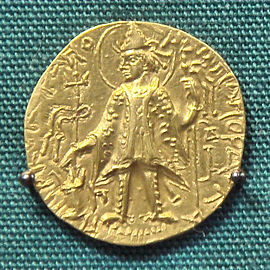Kanishka II
| Kanishka II | |
|---|---|
| Kushan emperor | |
 Coin with a depiction of Kanishka II. | |
| Reign | 200–222 CE |
| Predecessor | Vasudeva I |
| Successor | Vasishka |
| Kushan Empire 30 CE–350 CE | ||||||||||||||||||||||||||||||
|---|---|---|---|---|---|---|---|---|---|---|---|---|---|---|---|---|---|---|---|---|---|---|---|---|---|---|---|---|---|---|
|
||||||||||||||||||||||||||||||
Kanishka II (Brahmi: ![]()
![]()
![]() Kā-ṇi-ṣka) was one of the emperors of the Kushan Empire from around 225–245 CE. He succeeded Vasudeva I who is considered to be the last great Kushan emperor.[1]
Kā-ṇi-ṣka) was one of the emperors of the Kushan Empire from around 225–245 CE. He succeeded Vasudeva I who is considered to be the last great Kushan emperor.[1]
Rule[]
While he upheld Kushan rule in northern India, it is likely that Kanishka II lost the western part of his empire, namely Bactria/Tokharistan to the Sasanian Shapur I (240-272 CE), whose conquests would be consolidated by the Kushano-Sassanians.[1] In his inscriptions at Naqsh-e Rostam Shapur now claimed that he controlled the realm of the Kushans (Kūšān šahr) "up to Purushapura" (Peshawar), suggesting that he may have expanding even beyond the Hindu-Kush at the expense of the Kushans.[1] The rock inscription at Rag-i-Bibi further support this view.[1]
Several overstrikes by the Kushano-Sasanian Peroz I Kushanshah over coins of Kanishka II are known, and it is from the time of Peroz that the first Kushano-Sasanian coins were issued south of the Hindu-Kush.[2]
Kanishka II may have retaken control of Gandhara at one point, as well as Kapiśa, and there are suggestions that following these successes he may have created a second Era of Kanishka in celebration of the hundredth anniversary of the original one.[1]
Coinage and dated statuary[]

Coin of Kanishka II with Oesho.
Kanishka II with Ardoksho.

Statue of Hariti from Skarah Dheri, Gandhara, with the inscription "Year 399", probably in the Yavana era, hence 244 CE.[3]
Notes[]
References[]
- ^ Jump up to: a b c d e Rezakhani, Khodadad (2017). From the Kushans to the Western Turks. p. 202.
- ^ Cribb 2018, p. 20-21.
- ^ Rienjang, Wannaporn; Stewart, Peter, eds. (2017). Problems of Chronology in Gandharan Art (PDF). Archaeopress. pp. 35–51. ISBN 978-1-78491-856-9. Retrieved 27 May 2021.
Sources[]
- Cribb, Joe (2018). Problems of Chronology in Gandhāran Art: Proceedings of the First International Workshop of the Gandhāra Connections Project, University of Oxford, 23rd-24th March, 2017. University of Oxford The Classical Art Research Centre Archaeopress.
External links[]
| show |
|---|
- ^ From the dated inscription on the Rukhana reliquary
- ^ Richard Salomon (July–September 1996). "An Inscribed Silver Buddhist Reliquary of the Time of King Kharaosta and Prince Indravarman". Journal of the American Oriental Society. 116 (3): 418–452 [442]. JSTOR 605147.
- ^ Richard Salomon (1995) [Published online: 9 Aug 2010]. "A Kharosthī Reliquary Inscription of the Time of the Apraca Prince Visnuvarma". South Asian Studies. 11 (1): 27–32. doi:10.1080/02666030.1995.9628492.
- ^ Jump up to: a b c d e f g h i j k l m Jongeward, David; Cribb, Joe (2014). Kushan, Kushano-Sasanian, and Kidarite Coins A Catalogue of Coins From the American Numismatic Society by David Jongeward and Joe Cribb with Peter Donovan. p. 4.
- Kushan Empire
- 3rd-century Indian monarchs




